7.6 Inverse Trigonometric Functions
In this section we concern ourselves with finding inverses of the circular (trigonometric) functions.[1] Our immediate problem is that, owing to their periodic nature, none of the six circular functions are one-to-one. To remedy this, we restrict the domains of the circular functions in the same way we restricted the domain of the quadratic function in Example 5.1.3 in Section 5.1 to obtain a one-to-one function.
7.6.1 Inverses of Sine and Cosine
We start with [latex]f(t) = \sin(t)[/latex] and restrict our domain to [latex]\left[ -\frac{\pi}{2}, \frac{\pi}{2}\right][/latex] in order to keep the range as [latex][-1,1][/latex] as well as the properties of being smooth and continuous.

Recall from Section 5.1 that the inverse of a function [latex]f[/latex] is typically denoted [latex]f^{-1}[/latex]. For this reason, some textbooks use the notation [latex]f^{-1}(t) = \sin^{-1}(t)[/latex] for the inverse of [latex]f(t) = \sin(t)[/latex]. The obvious pitfall here is our convention of writing [latex](\sin(t))^2[/latex] as [latex]\sin^{2}(t)[/latex], [latex](\sin(t))^3[/latex] as [latex]\sin^{3}(t)[/latex] and so on. It is far too easy to confuse [latex]\sin^{-1}(t)[/latex] with [latex]\frac{1}{\sin(t)} = \csc(t)[/latex] so we will not use this notation in our text.[2]
Instead, we use the notation [latex]f^{-1}(t) = \arcsin(t)[/latex], read “arc-sine of [latex]t[/latex].” We’ll explain the arc in arcsine shortly. For now, we graph [latex]f(t) = \sin(t)[/latex] and [latex]f^{-1}(t) = \arcsin(t)[/latex], where we obtain the latter from the former by reflecting it across the line [latex]y=t[/latex], in accordance with Theorem 5.1.
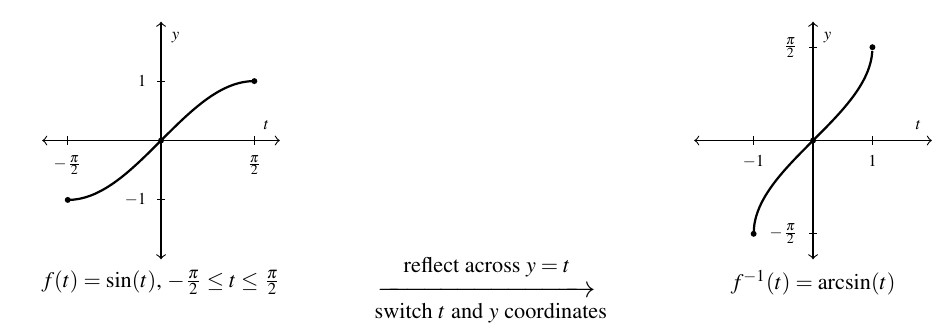
Next, we consider [latex]g(t) = \cos(t)[/latex]. Here, we select the interval [latex][0,\pi][/latex] for our restriction.

Reflecting the across the line [latex]y = t[/latex] produces the graph [latex]y = g^{-1}(t) = \arccos(t)[/latex].
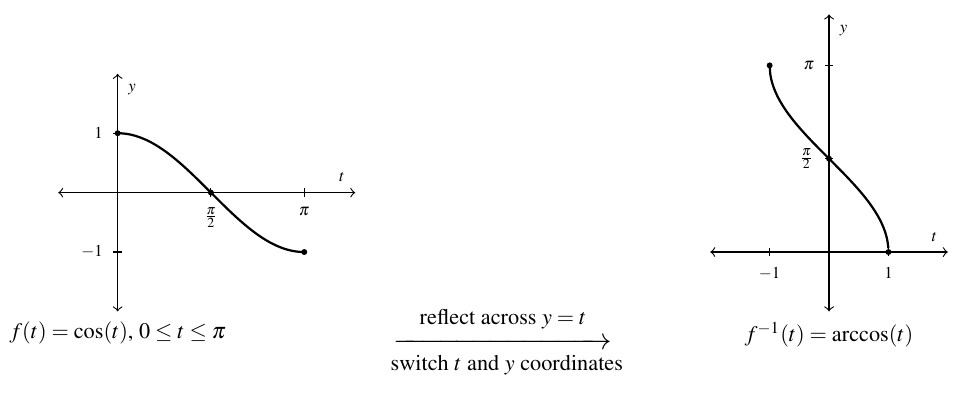
We list some important facts about the arcsine and arccosine functions in the following theorem.[3] Everything in Theorem 7.15 is a direct consequence of Theorem 5.1 as applied to the (restricted) sine and cosine functions, and as such, its proof is left to the reader.
Theorem 7.15 Properties of the Arcsine and Arccosine Functions
- Properties of [latex]F(x) = \arcsin(x)[/latex]
- Domain: [latex][-1,1][/latex]
- Range: [latex]\left[ -\frac{\pi}{2}, \frac{\pi}{2}\right][/latex]
- [latex]\arcsin(x) = t[/latex] if and only if [latex]\sin(t) = x[/latex] and [latex]-\frac{\pi}{2} \leq t \leq \frac{\pi}{2}[/latex]
- [latex]\sin(\arcsin(x)) = x[/latex] provided [latex]-1 \leq x \leq 1[/latex]
- [latex]\arcsin(\sin(t)) = t[/latex] provided [latex]-\frac{\pi}{2} \leq t \leq \frac{\pi}{2}[/latex]
- [latex]F(x) = \arcsin(x)[/latex] is odd
- Properties of [latex]G(x)= \arccos(x)[/latex]
- Domain: [latex][-1,1][/latex]
- Range: [latex][0,\pi][/latex]
- [latex]\arccos(x) = t[/latex] if and only if [latex]\cos(t) = x[/latex] and [latex]0 \leq t \leq \pi[/latex]
- [latex]\cos(\arccos(x)) = x[/latex] provided [latex]-1 \leq x \leq 1[/latex]
- [latex]\arccos(\cos(t)) = t[/latex] provided [latex]0 \leq t \leq \pi[/latex]
Before moving to an example, we take a moment to understand the arc in arcsine. Consider the figure below which illustrates the specific case of [latex]\arcsin\left(\frac{\sqrt{3}}{2} \right)[/latex].
By definition, the real number [latex]t = \arcsin\left(\frac{\sqrt{3}}{2} \right)[/latex] satisfies [latex]\sin(t) = \frac{\sqrt{3}}{2}[/latex] with [latex]-\frac{\pi}{2} \leq t \leq \frac{\pi}{2}[/latex]. In other words, we are looking for angle measuring [latex]t[/latex] radians between [latex]-\frac{\pi}{2}[/latex] and [latex]\frac{\pi}{2}[/latex] with a sine of [latex]\frac{\sqrt{3}}{2}[/latex]. Hence, [latex]\arcsin\left(\frac{\sqrt{3}}{2} \right) = \frac{\pi}{3}[/latex].
In terms of oriented arcs[4], if we start at [latex](1,0)[/latex] and travel along the Unit Circle in the positive (counterclockwise) direction for [latex]\frac{\pi}{3}[/latex] units, we will arrive at the point whose [latex]y[/latex]-coordinate is [latex]\frac{\sqrt{3}}{2}[/latex]. Hence, the real number [latex]\frac{\pi}{3}[/latex] also corresponds to arc corresponding to the sine that is [latex]\frac{\sqrt{3}}{2}[/latex].
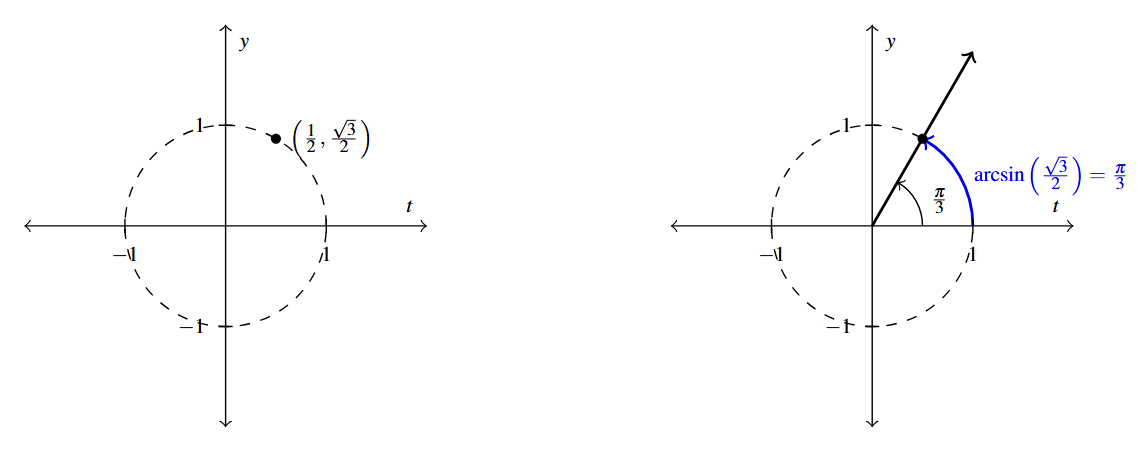
In general, the function [latex]f(t) = \sin(t)[/latex] takes a real number input [latex]t[/latex], associates it with the angle [latex]\theta = t[/latex] radians, and returns the value [latex]\sin(\theta)[/latex]. The value [latex]\sin(\theta) = \sin(t)[/latex] is the [latex]y[/latex]-coordinate of the terminal point on the Unit Circle of an oriented arc of length [latex]|t|[/latex] whose initial point is [latex](1, 0)[/latex].
Hence, we may view the inputs to [latex]f(t) = \sin(t)[/latex] as oriented arcs and the outputs as [latex]y[/latex]-coordinates on the Unit Circle. Therefore, the function [latex]f^{-1}[/latex] reverses this process and takes [latex]y[/latex]-coordinates on the Unit Circle and return oriented arcs, hence the arc in arcsine.
Example 7.6.1
Example 7.6.1.1a
Determine the exact values of the following.
[latex]\arcsin\left(\frac{\sqrt{2}}{2}\right)[/latex]
Solution:
The best way to approach these problems is to remember that [latex]\arcsin(x)[/latex] and [latex]\arccos(x)[/latex] are real numbers which correspond to the radian measure of angles that fall within a certain prescribed range.
Determine the exact value of [latex]\arcsin\left(\frac{\sqrt{2}}{2}\right)[/latex].
To find [latex]\arcsin\left(\frac{\sqrt{2}}{2}\right)[/latex], we need the angle measuring [latex]t[/latex] radians which lies between [latex]-\frac{\pi}{2}[/latex] and [latex]\frac{\pi}{2}[/latex] with [latex]\sin(t) = \frac{\sqrt{2}}{2}[/latex].
Hence, [latex]\arcsin\left(\frac{\sqrt{2}}{2}\right) = \frac{\pi}{4}[/latex].
Example 7.6.1.1b
Determine the exact values of the following.
[latex]\arccos\left(\frac{1}{2}\right)[/latex]
Solution:
The best way to approach these problems is to remember that [latex]\arcsin(x)[/latex] and [latex]\arccos(x)[/latex] are real numbers which correspond to the radian measure of angles that fall within a certain prescribed range.
Determine the exact value of [latex]\arccos\left(\frac{1}{2}\right)[/latex].
To find [latex]\arccos\left(\frac{1}{2}\right)[/latex], we are looking for the angle measuring [latex]t[/latex] radians which lies between 0 and [latex]\pi[/latex] that has [latex]\cos(t) = \frac{1}{2}[/latex].
Our answer is [latex]\arccos\left(\frac{1}{2}\right)= \frac{\pi}{3}[/latex].
Example 7.6.1.1c
Determine the exact values of the following.
[latex]\arcsin\left(-\frac{1}{2}\right)[/latex]
Solution:
The best way to approach these problems is to remember that [latex]\arcsin(x)[/latex] and [latex]\arccos(x)[/latex] are real numbers which correspond to the radian measure of angles that fall within a certain prescribed range.
Determine the exact value of [latex]\arcsin\left(-\frac{1}{2}\right)[/latex].
For [latex]\arcsin\left(-\frac{1}{2}\right)[/latex], we are looking for an angle measuring [latex]t[/latex] radians which lies between [latex]-\frac{\pi}{2}[/latex] and [latex]\frac{\pi}{2}[/latex] with [latex]\sin(t) = -\frac{1}{2}.[/latex]
Hence, [latex]\arcsin\left(-\frac{1}{2}\right) = -\frac{\pi}{6}[/latex].
Alternatively, we could use the fact that the arcsine function is odd, so [latex]\arcsin\left(-\frac{1}{2}\right) = - \arcsin\left(\frac{1}{2}\right)[/latex].
We find [latex]\arcsin\left(\frac{1}{2}\right) = \frac{\pi}{6}[/latex], so [latex]\arcsin\left(-\frac{1}{2}\right) = - \arcsin\left(\frac{1}{2}\right) = -\frac{\pi}{6}[/latex].
Example 7.6.1.1d
Determine the exact values of the following.
[latex]\arccos\left(-\frac{\sqrt{2}}{2}\right)[/latex]
Solution:
The best way to approach these problems is to remember that [latex]\arcsin(x)[/latex] and [latex]\arccos(x)[/latex] are real numbers which correspond to the radian measure of angles that fall within a certain prescribed range.
Determine the exact value of [latex]\arccos\left(-\frac{\sqrt{2}}{2}\right)[/latex].
For [latex]\arccos\left(-\frac{\sqrt{2}}{2}\right)[/latex], we need the angle measuring [latex]t[/latex] radians which lies between 0 and [latex]\pi[/latex] with [latex]\cos(t) = -\frac{\sqrt{2}}{2}[/latex].
Hence, [latex]\arccos\left(-\frac{\sqrt{2}}{2}\right) = \frac{3\pi}{4}[/latex].
Example 7.6.1.1e
Determine the exact values of the following.
[latex]\arccos\left( \cos\left(\frac{\pi}{6}\right)\right)[/latex]
Solution:
The best way to approach these problems is to remember that [latex]\arcsin(x)[/latex] and [latex]\arccos(x)[/latex] are real numbers which correspond to the radian measure of angles that fall within a certain prescribed range.
Determine the exact value of [latex]\arccos\left( \cos\left(\frac{\pi}{6}\right)\right)[/latex].
As [latex]0 \leq \frac{\pi}{6} \leq \pi[/latex], we could simply invoke Theorem 7.15 to get [latex]\arccos\left( \cos\left(\frac{\pi}{6}\right)\right) = \frac{\pi}{6}[/latex].
However, in order to make sure we understand why this is the case, we choose to work the example through using the definition of arccosine.
Working from the inside out, [latex]\arccos\left( \cos\left(\frac{\pi}{6}\right)\right) = \arccos\left( \frac{\sqrt{3}}{2}\right)[/latex].
To find [latex]\arccos\left( \frac{\sqrt{3}}{2}\right)[/latex], we need an angle measuring [latex]t[/latex] radians which lies between 0 and [latex]\pi[/latex] that has [latex]\cos(t) = \frac{\sqrt{3}}{2}[/latex].
We get [latex]t = \frac{\pi}{6}[/latex], so that [latex]\arccos\left( \cos\left(\frac{\pi}{6}\right)\right) = \arccos\left( \frac{\sqrt{3}}{2}\right) = \frac{\pi}{6}[/latex].
Example 7.6.1.1f
Determine the exact values of the following.
[latex]\arccos\left( \cos\left(\frac{11\pi}{6}\right)\right)[/latex]
Solution:
The best way to approach these problems is to remember that [latex]\arcsin(x)[/latex] and [latex]\arccos(x)[/latex] are real numbers which correspond to the radian measure of angles that fall within a certain prescribed range.
Determine the exact value of [latex]\arccos\left( \cos\left(\frac{11\pi}{6}\right)\right)[/latex].
[latex]\frac{11\pi}{6}[/latex] does not fall between 0 and [latex]\pi[/latex], therefore Theorem 7.15 does not apply. We are forced to work through from the inside out starting with [latex]\arccos\left( \cos\left(\frac{11\pi}{6}\right)\right) = \arccos\left(\frac{\sqrt{3}}{2}\right)[/latex]. From the previous problem, we know [latex]\arccos\left(\frac{\sqrt{3}}{2}\right) = \frac{\pi}{6}[/latex].
Hence, [latex]\arccos\left( \cos\left(\frac{11\pi}{6}\right)\right) = \frac{\pi}{6}[/latex].
Example 7.6.1.1g
Determine the exact values of the following.
[latex]\cos\left(\arccos\left(-\frac{3}{5}\right)\right)[/latex]
Solution:
The best way to approach these problems is to remember that [latex]\arcsin(x)[/latex] and [latex]\arccos(x)[/latex] are real numbers which correspond to the radian measure of angles that fall within a certain prescribed range.
Determine the exact value of [latex]\cos\left(\arccos\left(-\frac{3}{5}\right)\right)[/latex].
One way to simplify [latex]\cos\left(\arccos\left(-\frac{3}{5}\right)\right)[/latex] is to use Theorem 7.15 directly.
Because [latex]-\frac{3}{5}[/latex] is between [latex]-1[/latex] and 1, we have that [latex]\cos\left(\arccos\left(-\frac{3}{5}\right)\right) = -\frac{3}{5}[/latex] and we are done.
However, as before, to really understand why this cancellation occurs, we let [latex]t = \arccos\left(-\frac{3}{5}\right)[/latex]. By definition, [latex]\cos(t) = -\frac{3}{5}[/latex]. Hence, [latex]\cos\left(\arccos\left(-\frac{3}{5}\right)\right) = \cos(t) = -\frac{3}{5}[/latex], and we are finished in (nearly) the same amount of time.
Example 7.6.1.1h
Determine the exact values of the following.
[latex]\sin\left(\arccos\left(-\frac{3}{5}\right)\right)[/latex]
Solution:
The best way to approach these problems is to remember that [latex]\arcsin(x)[/latex] and [latex]\arccos(x)[/latex] are real numbers which correspond to the radian measure of angles that fall within a certain prescribed range.
Determine the exact value of [latex]\sin\left(\arccos\left(-\frac{3}{5}\right)\right)[/latex].
As in the previous example, we let [latex]t = \arccos\left(-\frac{3}{5}\right)[/latex] so that [latex]\cos(t) = -\frac{3}{5}[/latex] for some angle measuring [latex]t[/latex] radians between 0 and [latex]\pi[/latex].
For [latex]\cos(t)[/latex] < 0, we can narrow this down a bit and conclude that [latex]\frac{\pi}{2}[/latex] < [latex]t[/latex] < [latex]\pi[/latex], so that [latex]t[/latex] corresponds to an angle in Quadrant II.
In terms of [latex]t[/latex], then, we need to find [latex]\sin\left(\arccos\left(-\frac{3}{5}\right)\right) = \sin(t)[/latex], and because we know [latex]\cos(t)[/latex], the fastest route is using the Pythagorean Identity, [latex]x^{2} + y^{2} = 1[/latex] or [latex]\sin^{2} (t) + \cos^{2} (t) = 1[/latex].[5]
We get [latex]\sin^{2}(t) = 1 - \cos^{2}(t) = 1 - \left(-\frac{3}{5}\right)^2 = \frac{16}{25}[/latex]. [latex]t[/latex] corresponds to a Quadrant II angle, thus we choose the positive root, [latex]\sin(t) = \frac{4}{5}[/latex], so [latex]\sin\left(\arccos\left(-\frac{3}{5}\right)\right) = \frac{4}{5}[/latex].
Rewrite the composite function [latex]f(x) = \tan\left(\arccos\left(x \right)\right)[/latex] as algebraic functions of [latex]x[/latex] and state the domain.
Solution:
The best way to approach these problems is to remember that [latex]\arcsin(x)[/latex] and [latex]\arccos(x)[/latex] are real numbers which correspond to the radian measure of angles that fall within a certain prescribed range.
Rewrite [latex]f(x) = \tan\left(\arccos\left(x \right)\right)[/latex] as an algebraic function of [latex]x[/latex] and state the domain.
We begin this problem in the same manner we began the previous two problems. We let [latex]t = \arccos(x)[/latex], so our goal is to find a way to express [latex]\tan\left(\arccos\left(x \right)\right) = \tan(t)[/latex] in terms of [latex]x[/latex].
By letting [latex]t = \arccos(x)[/latex], we know [latex]\cos(t) = x[/latex] where [latex]0 \leq t \leq \pi[/latex]. One approach[6] to finding [latex]\tan(t)[/latex] is to use the quotient identity [latex]\tan(t) = \frac{\sin(t)}{\cos(t)}[/latex]. As we know [latex]\cos(t)[/latex], we just need to find [latex]\sin(t)[/latex].
Using the Pythagorean Identity, [latex]\sin^{2} (t) + \cos^{2} (t) = 1[/latex], we get [latex]\sin^{2}(t) = 1 - \cos^{2}(t) = 1 - x^2[/latex] so that [latex]\sin(t) = \pm \sqrt{1-x^2}[/latex]. Given [latex]0 \leq t \leq \pi[/latex], [latex]\sin(t) \geq 0[/latex] and [latex]\sin(t) = \sqrt{1-x^2}[/latex].
Thus, [latex]\tan(t) = \frac{\sin(t)}{\cos(t)} = \frac{\sqrt{1-x^2}}{x}[/latex], so [latex]f(x) = \tan(\arccos(x)) = \frac{\sqrt{1-x^2}}{x}[/latex].
To determine the domain, we harken back to Section 1.5.2. The function [latex]f(x) = \tan\left(\arccos\left(x \right)\right)[/latex] can be thought of as a two step process: first, take the arccosine of a number, and second, take the tangent of whatever comes out of the arccosine.
The domain of [latex]\arccos(x)[/latex] is [latex]-1 \leq x \leq 1[/latex], so the domain of [latex]f[/latex] will be some subset of [latex][-1,1][/latex]. The range of [latex]\arccos(x)[/latex] is [latex][0,\pi][/latex], and of these values, only [latex]\frac{\pi}{2}[/latex] will cause a problem for the tangent function. As [latex]\arccos(x) = \frac{\pi}{2}[/latex] happens when [latex]x = \cos\left(\frac{\pi}{2} \right) = 0[/latex], we exclude [latex]x=0[/latex] from our domain. Hence, the domain of [latex]f(x) = \tan\left(\arccos\left(x \right)\right) =\frac{\sqrt{1-x^2}}{x}[/latex] is [latex][-1,0)\cup(0,1][/latex].
Note that in this particular case, we could have obtained the correct domain of [latex]f[/latex] using its algebraic description: [latex]f(x) = \tan(\arccos(x)) = \frac{\sqrt{1-x^2}}{x}[/latex]. This is not always true, however, as we’ll see soon.
7.6.2 Inverses of Tangent and Cotangent
The next pair of functions we wish to discuss are the inverses of tangent and cotangent. First, we restrict [latex]f(t) = \tan(t)[/latex] to its fundamental cycle on [latex]\left(-\frac{\pi}{2}, \frac{\pi}{2}\right)[/latex] to obtain the arctangent function, [latex]f^{-1}(t) = \arctan(t)[/latex]. Among other things, note that the vertical asymptotes [latex]t = -\frac{\pi}{2}[/latex] and [latex]t = \frac{\pi}{2}[/latex] of the graph of [latex]f(t) = \tan(t)[/latex] become the horizontal asymptotes [latex]y = -\frac{\pi}{2}[/latex] and [latex]y = \frac{\pi}{2}[/latex] of the graph of [latex]f^{-1}(t) = \arctan(t)[/latex].
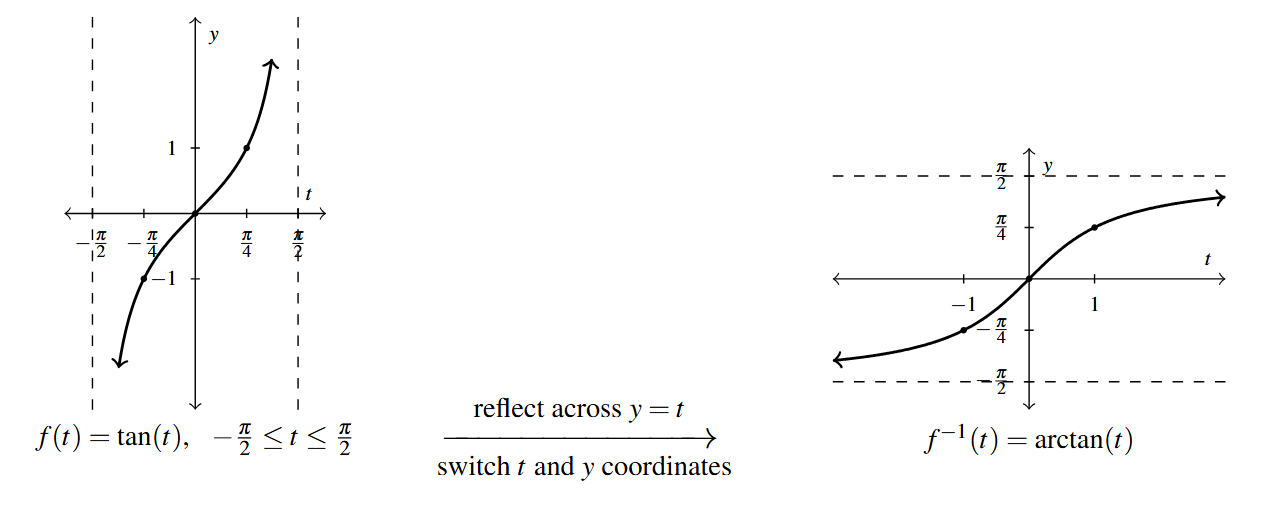
Next, we restrict [latex]g(t) = \cot(t)[/latex] to its fundamental cycle on [latex](0,\pi)[/latex] to obtain [latex]g^{-1}(t) = \text{arccot}(t)[/latex], the arccotangent function. Once again, the vertical asymptotes [latex]t=0[/latex] and [latex]t=\pi[/latex] of the graph of [latex]g(t) = \cot(t)[/latex] become the horizontal asymptotes [latex]y = 0[/latex] and [latex]y = \pi[/latex] of the graph of [latex]g^{-1}(t) = \text{arccot}(t)[/latex].
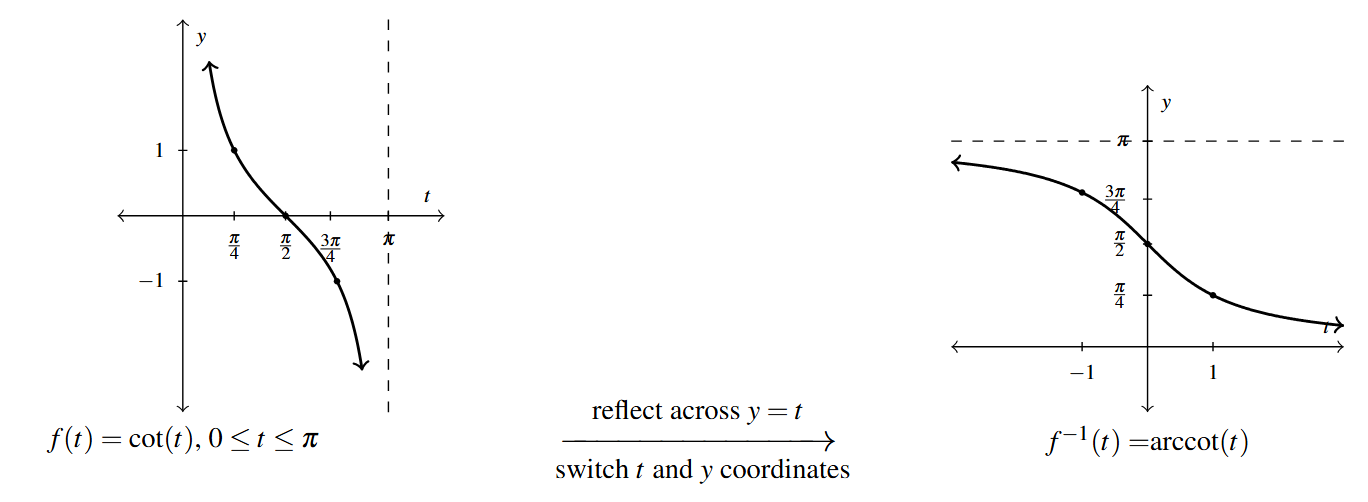
Below we summarize the important properties of the arctangent and arccotangent functions.
Theorem 7.16 Properties of the Arctangent and Arccotangent Functions
- Properties of [latex]F(x)= \arctan(x)[/latex]
- Domain: [latex](-\infty, \infty)[/latex]
- Range: [latex]\left(-\frac{\pi}{2}, \frac{\pi}{2}\right)[/latex]
- as [latex]x \rightarrow -\infty[/latex], [latex]\arctan(x) \rightarrow -\frac{\pi}{2}^{+}[/latex]; as [latex]x \rightarrow \infty[/latex], [latex]\arctan(x) \rightarrow \frac{\pi}{2}^{-}[/latex]
- [latex]\arctan(x) = t[/latex] if and only if [latex]\tan(t) = x[/latex] and [latex]-\frac{\pi}{2}[/latex] < [latex]t[/latex] < [latex]\frac{\pi}{2}[/latex]
- [latex]\arctan(x) = \text{arccot}\left(\frac{1}{x}\right)[/latex] for [latex]x > 0[/latex]
- [latex]\tan\left(\arctan(x)\right) = x[/latex] for all real numbers [latex]x[/latex]
- [latex]\arctan(\tan(t)) = t[/latex] provided [latex]-\frac{\pi}{2}[/latex] < [latex]t[/latex] < [latex]\frac{\pi}{2}[/latex]
- [latex]F(x)= \arctan(x)[/latex] is odd
- Properties of [latex]G(x) = \text{arccot}(x)[/latex]
- Domain: [latex](-\infty, \infty)[/latex]
- Range: [latex](0, \pi)[/latex]
- as [latex]x \rightarrow -\infty[/latex], [latex]\text{arccot}(x) \rightarrow \pi^{-}[/latex]; as [latex]x \rightarrow \infty[/latex], [latex]\text{arccot}(x) \rightarrow 0^{+}[/latex]
- [latex]\text{arccot}(x) = t[/latex] if and only if [latex]\cot(t) = x[/latex] and 0 < [latex]t[/latex] < [latex]\pi[/latex]
- [latex]\text{arccot}(x) =\arctan\left(\frac{1}{x}\right)[/latex] for [latex]x > 0[/latex]
- [latex]\cot\left(\text{arccot}(x)\right) = x[/latex] for all real numbers [latex]x[/latex]
- [latex]\text{arccot}(\cot(t)) = t[/latex] provided 0 < [latex]t[/latex] < [latex]\pi[/latex]
The properties listed in Theorem 7.16 are consequences of the definitions of the arctangent and arccotangent functions along with Theorem 5.1, and its proof is left to the reader.
Example 7.6.2
Example 7.6.2.1a
Determine the exact values of the following.
[latex]\arctan(\sqrt{3})[/latex]
Solution:
Determine the exact value of [latex]\arctan(\sqrt{3})[/latex].
To find [latex]\arctan(\sqrt{3})[/latex], we need the angle measuring [latex]t[/latex] radians which lies between [latex]-\frac{\pi}{2}[/latex] and [latex]\frac{\pi}{2}[/latex] with [latex]\tan(t) = \sqrt{3}[/latex].
We find [latex]\arctan(\sqrt{3}) = \frac{\pi}{3}[/latex].
Example 7.6.2.1b
Determine the exact values of the following.
[latex]\text{arccot}(-\sqrt{3})[/latex]
Solution:
Determine the exact value of [latex]\text{arccot}(-\sqrt{3})[/latex].
To find [latex]\text{arccot}(-\sqrt{3})[/latex], we need the angle measuring [latex]t[/latex] radians which lies between 0 and [latex]\pi[/latex] with [latex]\cot(t) = -\sqrt{3}[/latex].
Hence, [latex]\text{arccot}(-\sqrt{3}) = \frac{5\pi}{6}[/latex].
Example 7.6.2.1c
Determine the exact values of the following.
[latex]\cot(\text{arccot}(-5))[/latex]
Solution:
Determine the exact value of [latex]\cot(\text{arccot}(-5))[/latex].
We can apply Theorem 7.16 directly and obtain [latex]\cot(\text{arccot}(-5)) = -5[/latex]. However, working it through provides us with yet another opportunity to understand why this is the case.
Letting [latex]t = \text{arccot}(-5)[/latex], by definition, [latex]\cot(t)=-5[/latex].
Hence, [latex]\cot(\text{arccot}(-5)) = \cot(t)=-5[/latex].
Example 7.6.2.1d
Determine the exact values of the following.
[latex]\sin\left(\arctan\left(-\frac{4}{3}\right)\right)[/latex]
Solution:
Determine the exact value of [latex]\sin\left(\arctan\left(-\frac{4}{3}\right)\right)[/latex].
We start simplifying [latex]\sin\left(\arctan\left(-\frac{4}{3}\right)\right)[/latex] by letting [latex]t = \arctan\left(-\frac{4}{3}\right)[/latex]. By definition, [latex]\tan(t) = -\frac{4}{3}[/latex] for some angle measuring [latex]t[/latex] radians which lies between [latex]-\frac{\pi}{2}[/latex] and [latex]\frac{\pi}{2}[/latex]. As [latex]\tan(t)[/latex] < 0, we know, in fact, [latex]t[/latex] corresponds to a Quadrant IV angle.
We are given [latex]\tan(t)[/latex] but wish to know [latex]\sin(t)[/latex]. There is no direct identity to marry the two, so we make a quick sketch of the situation below. Because [latex]\tan(t) = -\frac{4}{3} = \frac{-4}{3}[/latex], we take [latex]P(3,-4)[/latex] as a point on the terminal side of [latex]\theta = t = \arctan\left(-\frac{4}{3}\right)[/latex] radians.
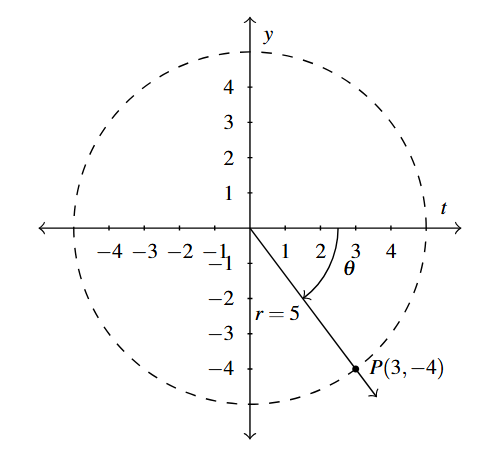
We find [latex]r = \sqrt{x^2+y^2} = \sqrt{(3)^2+(-4)^2} = 5[/latex], so [latex]\sin(t) = -\frac{4}{5}[/latex].
Example 7.6.2.2a
Rewrite each of the following composite functions as algebraic functions of [latex]x[/latex] and state the domain.
[latex]\tan(2 \arctan(x))[/latex]
Solution:
Rewrite [latex]\tan(2 \arctan(x))[/latex] as an algebraic function of [latex]x[/latex] and state the domain.
We proceed as above and let [latex]t = \arctan(x)[/latex]. We have [latex]\tan(t) = x[/latex] where [latex]-\frac{\pi}{2}[/latex] < [latex]t[/latex] < [latex]\frac{\pi}{2}[/latex]. Our goal is to express [latex]\tan(2 \arctan(x)) = \tan(2t)[/latex] in terms of [latex]x[/latex].
From Theorem 8.9, we will learn [latex]\tan(2t) = \frac{2 \tan(t)}{1 - \tan^{2}(t)} = \frac{2x}{1-x^2}[/latex].
Hence [latex]f(x) = \tan(2 \arctan(x)) = \frac{2x}{1-x^2}[/latex].
To find the domain, we once again think of [latex]f(x) = \tan(2 \arctan(x))[/latex] as a sequence of steps and work from the inside out.
The first step is to find the arctangent of a real number. The domain of [latex]\arctan(x)[/latex] is all real numbers, so we have no restrictions here and we get out all values [latex]\left(-\frac{\pi}{2}, \frac{\pi}{2} \right)[/latex].
The next step is to multiply [latex]\arctan(x)[/latex] by 2. There are no restrictions here, either. The range of [latex]\arctan(x)[/latex] is [latex]\left(-\frac{\pi}{2}, \frac{\pi}{2} \right)[/latex], thus the range of [latex]2 \arctan(x)[/latex] is [latex](-\pi, \pi)[/latex].
The last step is to take the tangent of [latex]2 \arctan(x)[/latex]. As we are taking the tangent of values in the interval [latex](-\pi, \pi)[/latex], we will run into trouble if [latex]2 \arctan(x) = \pm \frac{\pi}{2}[/latex], that is, if [latex]\arctan(x) = \pm \frac{\pi}{4}[/latex]. This happens exactly when [latex]x = \tan\left( \pm \frac{\pi}{4}\right) = \pm 1[/latex], so we must exclude [latex]x = \pm 1[/latex] from the domain of [latex]f[/latex].
Hence, the domain of [latex]f(x) = \tan(2 \arctan(x))[/latex] is [latex](-\infty, -1) \cup (-1,1) \cup (1,\infty)[/latex]. In this example, we could have obtained the correct answer by looking at the algebraic equivalence, [latex]f(x) = \frac{2x}{1-x^2}[/latex].
Example 7.6.2.2b
Rewrite each of the following composite functions as algebraic functions of [latex]x[/latex] and state the domain.
[latex]\cos(\text{arccot}(2x))[/latex]
Solution:
Rewrite [latex]\cos(\text{arccot}(2x))[/latex] as an algebraic function of [latex]x[/latex] and state the domain.
To get started, we let [latex]t = \text{arccot}(2x)[/latex] so that [latex]\cot(t) = 2x[/latex] where 0 < [latex]t[/latex] < [latex]\pi[/latex]. In terms of [latex]t[/latex], [latex]\cos(\text{arccot}(2x)) = \cos(t)[/latex], and our goal is to express the latter in terms of [latex]x[/latex].
One way to proceed is to rewrite the identity [latex]\cot(t) = \frac{\cos(t)}{\sin(t)}[/latex] as [latex]\cos(t) = \cot(t) \sin(t)[/latex] and use the fact that [latex]\cot(t) = 2x[/latex] to find [latex]\sin(t)[/latex] in terms of [latex]x[/latex]. This isn’t as hopeless as it might seem, because the Pythagorean Identity [latex]\csc^{2}(t) = 1 + \cot^{2}(t)[/latex] relates cotangent to cosecant, and [latex]\sin(t) = \frac{1}{\csc(t)}[/latex].
Following this strategy, we get [latex]\csc^{2} (t) = 1 + \cot^{2}(t) = 1 + (2x)^2 = 1 + 4x^2[/latex] so [latex]\csc(t) = \pm \sqrt{4x^2+1}[/latex]. Due to the fact that [latex]t[/latex] is between 0 and [latex]\pi[/latex], [latex]\csc(t) > 0[/latex]. Hence, [latex]\csc(t) =\sqrt{4x^2+1}[/latex], so [latex]\sin(t) = \frac{1}{\csc(t)} = \frac{1}{\sqrt{4x^2+1}}[/latex].
We find [latex]\cos(t) = \cot(t) \sin(t) = \frac{2x}{\sqrt{4x^2+1}}[/latex]. Hence, [latex]g(x) = \cos(\text{arccot}(2x)) = \frac{2x}{\sqrt{4x^2+1}}[/latex].
Viewing [latex]g(x) = \cos(\text{arccot}(2x))[/latex] as a sequence of steps, we see we first double the input [latex]x[/latex], then take the arccotangent, and, finally, take the cosine. Each of these processes are valid for all real numbers, so the domain of [latex]g[/latex] is [latex](-\infty, \infty)[/latex].
The reader may well wonder if there isn’t a more direct way to handle Example 7.6.2 number 2b. Indeed, we can take some inspiration from Section 7.4 and imagine an angle [latex]\theta[/latex] measuring [latex]t[/latex] radians so that [latex]\cot(\theta) = \cot(t) = 2x[/latex] where 0 < [latex]\theta[/latex] < [latex]\pi[/latex].
Thinking of [latex]\cot(\theta)[/latex] as a ratio of coordinates on a circle, we may rewrite [latex]\cot(\theta) = 2x = \frac{2x}{1}[/latex] and we would like to identify a point [latex]P(2x,1)[/latex] on the terminal side of [latex]\theta[/latex].
We need to be careful here. Given [latex]\cot(\theta) = 2x[/latex], [latex]x = \frac{1}{2} \cot(\theta)[/latex], so as [latex]\theta[/latex] ranges between 0 and [latex]\pi[/latex], [latex]x[/latex] can take on positive, negative or 0 values. We need to argue that the point [latex]P(2x,1)[/latex] lies in the quadrant we expect (as depicted below) in all cases before we delve too far into our analysis.

If 0 < [latex]\theta[/latex] < [latex]\frac{\pi}{2}[/latex], then [latex]\cot(\theta) > 0[/latex]. Hence, [latex]x>0[/latex] so the point [latex]P(2x,1)[/latex] is in Quadrant I, as required. If [latex]\theta = \frac{\pi}{2}[/latex], then [latex]x = 0[/latex], and our point [latex]P(2x,1) = (0,1)[/latex], as required. If [latex]\frac{\pi}{2}[/latex] < [latex]\theta[/latex] < [latex]\pi[/latex], then [latex]\cot(\theta)[/latex] < 0. Hence, [latex]x[/latex] < 0, so [latex]P(2x,1)[/latex] is in Quadrant II, as required.
Hence, in all three cases, our formula for the point [latex]P(2x,1)[/latex] determines a point in the same quadrant as the terminal side of [latex]\theta[/latex], as illustrated above.
This allows us to use Theorem 7.10 from Section 7.4. We find [latex]r = \sqrt{(2x)^2+1^2} = \sqrt{4x^2+1}[/latex], and hence, [latex]\cos(\theta) = \frac{2x}{\sqrt{4x^2+1}}[/latex], which agrees with our answer from Example 7.6.2.
It shouldn’t surprise the reader that there are some cases where the approach outlined above doesn’t go as smoothly (as we’ll see in the discussion following Example 7.6.3.)
The last two functions to invert are secant and cosecant. A portion of each of their graphs, which were first discussed in Subsection 7.5.1, are given below with the fundamental cycles highlighted.

It is clear from the graph of secant that we cannot find one single continuous piece of its graph which covers its entire range of [latex](-\infty, -1] \cup [1, \infty)[/latex] and restricts the domain of the function so that it is one-to-one. The same is true for cosecant.
Thus in order to define the arcsecant and arccosecant functions, we must settle for a piecewise approach wherein we choose one piece to cover the top of the range, namely [latex][1, \infty)[/latex], and another piece to cover the bottom, namely [latex](-\infty, -1][/latex].
There are two generally accepted ways to make these choices which restrict the domains of these functions so that they are one-to-one. One approach simplifies the Trigonometry associated with the inverse functions, but complicates the Calculus; the other makes the Calculus easier, but the Trigonometry less so. We choose to focus on the Trigonometric approach.
7.6.3 Inverses of Secant and Cosecant
In this subsection, we restrict the secant and cosecant functions to coincide with the restrictions on cosine and sine, respectively. For [latex]f(t) = \sec(t)[/latex], we restrict the domain to [latex]\left[0, \frac{\pi}{2}\right) \cup \left( \frac{\pi}{2}, \pi\right][/latex]
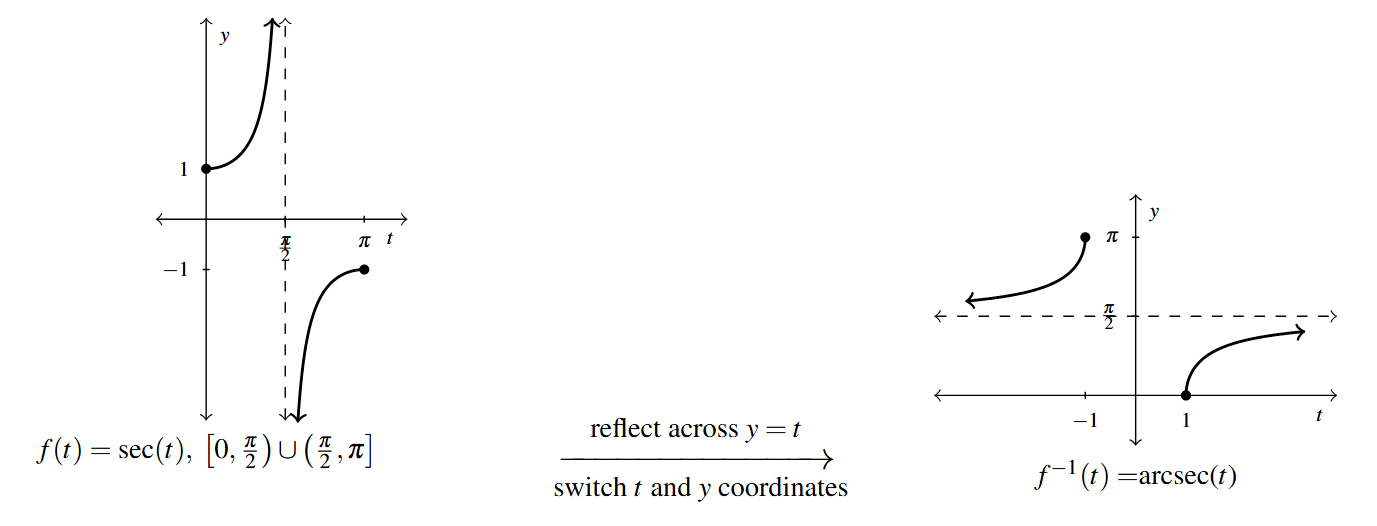
and we restrict [latex]g(t) = \csc(t)[/latex] to [latex]\left[-\frac{\pi}{2}, 0\right) \cup \left(0, \frac{\pi}{2}\right][/latex].
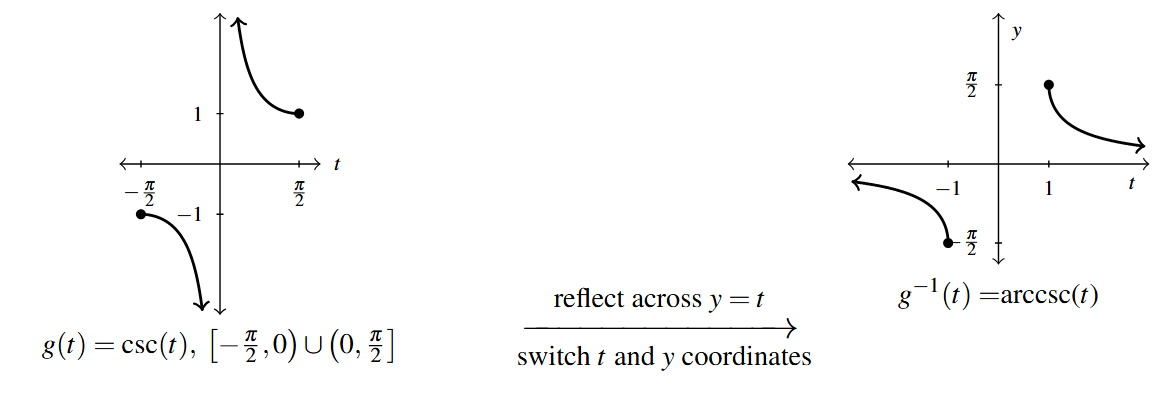
Note that for both arcsecant and arccosecant, the domain is [latex](-\infty, -1] \cup [1, \infty)[/latex]. Taking a page from Section 0.6.2, we can rewrite this as [latex]\left\{ x \, | \, |x| \geq 1\right\}[/latex]. (This is often done in Calculus textbooks, so we include it here for completeness.)
Using these definitions along with Theorem 5.1, we get the following properties of the arcsecant and arccosecant functions.
Theorem 7.17 Properties of the Arcsecant and Arccosecant Functions
- Properties of [latex]F(x)= \text{arcsec}(x)[/latex]
- Domain: [latex]\left\{ x \, | \, |x| \geq 1 \right\} = (-\infty, -1] \cup [1,\infty)[/latex]
- Range: [latex]\left[0, \frac{\pi}{2} \right) \cup \left(\frac{\pi}{2}, \pi\right][/latex]
- as [latex]x \rightarrow -\infty[/latex], [latex]\text{arcsec}(x) \rightarrow \frac{\pi}{2}^{+}[/latex]; as [latex]x \rightarrow \infty[/latex], [latex]\text{arcsec}(x) \rightarrow \frac{\pi}{2}^{-}[/latex]
- [latex]\text{arcsec}(x) = t[/latex] if and only if [latex]\sec(t) = x[/latex] and [latex]0 \leq t[/latex] < [latex]\frac{\pi}{2}[/latex] or [latex]\frac{\pi}{2}[/latex] < [latex]t \leq \pi[/latex]
- [latex]\text{arcsec}(x) = \arccos\left(\frac{1}{x}\right)[/latex] provided [latex]|x| \geq 1[/latex]
- [latex]\sec\left(\text{arcsec}(x)\right) = x[/latex] provided [latex]|x| \geq 1[/latex]
- [latex]\text{arcsec}(\sec(t)) = t[/latex] provided [latex]0 \leq t[/latex] < [latex]\frac{\pi}{2}[/latex] or [latex]\frac{\pi}{2}[/latex] < [latex]t \leq \pi[/latex]
- Properties of [latex]G(x) = \text{arccsc}(x)[/latex]
- Domain: [latex]\left\{ x \, | \, |x| \geq 1 \right\} = (-\infty, -1] \cup [1,\infty)[/latex]
- Range: [latex]\left[-\frac{\pi}{2}, 0 \right) \cup \left(0, \frac{\pi}{2} \right][/latex]
- as [latex]x \rightarrow -\infty[/latex], [latex]\text{arccsc}(x) \rightarrow 0^{-}[/latex]; as [latex]x \rightarrow \infty[/latex], [latex]\text{arccsc}(x) \rightarrow 0^{+}[/latex]
- [latex]\text{arccsc}(x) = t[/latex] if and only if [latex]\csc(t) = x[/latex] and [latex]-\frac{\pi}{2} \leq t[/latex] < 0 or 0 < [latex]t \leq \frac{\pi}{2}[/latex]
- [latex]\text{arccsc}(x) = \arcsin\left(\frac{1}{x}\right)[/latex] provided [latex]|x| \geq 1[/latex]
- [latex]\csc\left(\text{arccsc}(x)\right) = x[/latex] provided [latex]|x| \geq 1[/latex]
- [latex]\text{arccsc}(\csc(t)) = t[/latex] provided [latex]-\frac{\pi}{2} \leq t[/latex] < 0 or 0 < [latex]t \leq \frac{\pi}{2}[/latex]
- [latex]G(x) = \text{arccsc}(x)[/latex] is odd
The reason the ranges here are called Trigonometry Friendly is specifically because of two properties listed in Theorem 7.17: [latex]\text{arcsec}(x) = \arccos\left(\frac{1}{x}\right)[/latex] and [latex]\text{arccsc}(x) = \arcsin\left(\frac{1}{x}\right)[/latex].
Note: We may also adjust the restriction of [latex]f(t) = \sec (t)[/latex] to [latex]\left[ 0 , \frac{\pi}{2} \right) \cup \left[ \pi, \frac{3 \pi}{2} \right)[/latex] and [latex]g(t) = \csc (t)[/latex] to [latex]\left( 0 , \frac{\pi}{2} \right] \cup \left( \pi, \frac{3 \pi}{2} \right][/latex] to develop Calculus Friendly ranges of [latex]\left[ 0 , \frac{\pi}{2} \right) \cup \left[ \pi, \frac{3 \pi}{2} \right)[/latex] for [latex]F(x) = \text{arcsec} (x)[/latex] and [latex]\left( 0 , \frac{\pi}{2} \right] \cup \left( \pi, \frac{3 \pi}{2} \right][/latex] for [latex]G(x) = \text{arccsc} (x)[/latex]. At this time it is difficult to explain why these choices for the ranges of arcsecant and arccosecant are Calculus Friendly.
These formulas essentially allow us to always convert arcsecants and arccosecants back to arccosines and arcsines, respectively. We see this play out in our next example.
Example 7.6.3
Example 7.6.3.1a
Determine the exact values of the following.
[latex]\text{arcsec}(2)[/latex]
Solution:
Determine the exact value of [latex]\text{arcsec}(2)[/latex].
Using Theorem 7.17, we have [latex]\text{arcsec}(2) = \arccos\left(\frac{1}{2}\right) = \frac{\pi}{3}[/latex].
Example 7.6.3.1b
Determine the exact values of the following.
[latex]\text{arccsc}(-2)[/latex]
Solution:
Determine the exact value of [latex]\text{arccsc}(-2)[/latex].
Once again, Theorem 7.17 comes to our aid giving [latex]\text{arccsc}(-2) = \arcsin\left(-\frac{1}{2}\right) = -\frac{\pi}{6}[/latex].
Example 7.6.3.1c
Determine the exact values of the following.
[latex]\text{arcsec}\left( \sec\left( \frac{5\pi}{4} \right) \right)[/latex]
Solution:
Determine the exact value of [latex]\text{arcsec}\left( \sec\left( \frac{5\pi}{4} \right) \right)[/latex].
[latex]\frac{5\pi}{4}[/latex] doesn’t fall between 0 and [latex]\frac{\pi}{2}[/latex] or [latex]\frac{\pi}{2}[/latex] and [latex]\pi[/latex], thus we cannot use the inverse property stated in Theorem 7.17. Hence, we work from the inside out.
We get: [latex]\text{arcsec}\left( \sec\left( \frac{5\pi}{4} \right) \right) = \text{arcsec}(-\sqrt{2}) = \arccos\left(-\frac{1}{\sqrt{2}}\right) =\arccos\left(-\frac{\sqrt{2}}{2}\right) = \frac{3\pi}{4}[/latex].
Example 7.6.3.1d
Determine the exact values of the following.
[latex]\cot\left(\text{arccsc}\left(-3\right)\right)[/latex]
Solution:
Determine the exact value of [latex]\cot\left(\text{arccsc}\left(-3\right)\right)[/latex].
We begin simplifying [latex]\cot\left(\text{arccsc}\left(-3\right)\right)[/latex] by letting [latex]t = \text{arccsc}(-3)[/latex]. Then, [latex]\csc(t) = -3[/latex]. For [latex]\csc(t)[/latex] < 0, [latex]t[/latex] lies in the interval [latex]\left[ -\frac{\pi}{2},0\right)[/latex], so [latex]t[/latex] corresponds to a Quadrant IV angle.
To find [latex]\cot\left(\text{arccsc}\left(-3\right)\right) = \cot(t)[/latex], we use the Pythagorean Identity: [latex]\cot^{2}(t) = \csc^{2}(t)-1[/latex]. We get [latex]\csc^{2}(t) = (-3)^2 - 1 = 8[/latex], or [latex]\cot(t) = \pm \sqrt{8} = \pm 2 \sqrt{2}[/latex].
As [latex]t[/latex] corresponds to a Quadrant IV angle, [latex]\cot(t)[/latex] < 0.
Hence, [latex]\cot\left(\text{arccsc}\left(-3\right)\right) = -2\sqrt{2}[/latex].
Example 7.6.3.2a
Rewrite each of the following composite functions as algebraic functions of [latex]x[/latex] and state the domain.
[latex]f(x) = \tan(\text{arcsec}(x))[/latex]
Solution:
Rewrite [latex]f(x) = \tan(\text{arcsec}(x))[/latex] as an algebraic function of [latex]x[/latex] and state the domain.
Proceeding as above, we let [latex]t = \text{arcsec}(x)[/latex]. Then, [latex]\sec(t) = x[/latex] for [latex]t[/latex] in [latex]\left[0, \frac{\pi}{2}\right) \cup \left(\frac{\pi}{2}, \pi \right][/latex]. We seek a formula for [latex]\tan(\text{arcsec}(x)) = \tan(t)[/latex] in terms of [latex]x[/latex].
To relate [latex]\sec(t)[/latex] to [latex]\tan(t)[/latex], we use the Pythagorean Identity: [latex]\tan^{2}(t) = \sec^{2}(t) - 1[/latex]. Substituting [latex]\sec(t) = x[/latex], we get [latex]\tan^{2}(t) = \sec^{2}(t) - 1 = x^2-1[/latex], so [latex]\tan(t) = \pm \sqrt{x^2-1}.[/latex]
If [latex]t[/latex] belongs to [latex]\left[0, \frac{\pi}{2}\right)[/latex] then [latex]\tan(t) \geq 0[/latex]. On the the other hand, if [latex]t[/latex] belongs to [latex]\left(\frac{\pi}{2}, \pi \right][/latex] then [latex]\tan(t) \leq 0[/latex]. As a result, we get a piecewise defined function for [latex]\tan(t)[/latex]:
\[ \tan(t) = \left\{ \begin{array}{rr} \sqrt{x^2-1}, & \text{if } 0 \leq t \text{ < } \frac{\pi}{2} \\ & \\ -\sqrt{x^2-1}, & \text{if } \frac{\pi}{2} \text{ < } t \leq \pi \end{array}\right. \]
Now we need to determine what these conditions on [latex]t[/latex] mean for [latex]x[/latex]. For [latex]x = \sec(t)[/latex], when [latex]0 \leq t[/latex] < [latex]\frac{\pi}{2}[/latex], [latex]x \geq 1[/latex], and when [latex]\frac{\pi}{2}[/latex] < [latex]t \leq \pi[/latex], [latex]x \leq -1[/latex],
\[f(x) = \tan(\text{arcsec}(x)) = \left\{ \begin{array}{rr} \sqrt{x^2-1}, & \text{if } x \geq 1 \\ & \\ -\sqrt{x^2-1}, & \text{if } x \leq -1 \end{array}\right. \]
To find the domain of [latex]f[/latex], we consider [latex]f(x) = \tan(\text{arcsec}(x))[/latex] as a two step process. First, we have the arcsecant function, whose domain is [latex](\-\infty, -1] \cup [1, \infty).[/latex]
The range of [latex]\text{arcsec}(x)[/latex] is [latex]\left[0, \frac{\pi}{2}\right) \cup \left(\frac{\pi}{2}, \pi \right][/latex], so taking the tangent of any output from [latex]\text{arcsec}(x)[/latex] is defined. Hence, the domain of [latex]f[/latex] is [latex](-\infty, -1] \cup [1, \infty).[/latex]
Example 7.6.3.2b
Rewrite each of the following composite functions as algebraic functions of [latex]x[/latex] and state the domain.
[latex]g(x) = \cos(\text{arccsc}(4x))[/latex]
Solution:
Rewrite [latex]g(x) = \cos(\text{arccsc}(4x))[/latex] as an algebraic function of [latex]x[/latex] and state the domain.
Taking a cue from the previous problem, we start by letting [latex]t = \text{arccsc}(4x)[/latex]. Then [latex]\csc(t) = 4x[/latex] for [latex]t[/latex] in [latex]\left[-\frac{\pi}{2}, 0 \right) \cup \left(0, \frac{\pi}{2}\right][/latex]. Our goal is to rewrite [latex]\cos(\text{arccsc}(4x)) = \cos(t)[/latex] in terms of [latex]x[/latex].
From [latex]\csc(t) = 4x[/latex], we get [latex]\sin(t) = \frac{1}{4x}[/latex], so to find [latex]\cos(t)[/latex], we can make use of the Pythagorean Identity: [latex]\cos^{2}(t)= 1- \sin^{2}(t)[/latex]. Substituting [latex]\sin(t) = \frac{1}{4x}[/latex] gives [latex]\cos^{2}(t) = 1 - \left(\frac{1}{4x}\right)^2 = 1 - \frac{1}{16x^2}[/latex]. Getting a common denominator and extracting square roots, we obtain: \[\cos(t) = \pm \sqrt{\frac{16x^2-1}{16x^2}} = \pm \frac{\sqrt{16x^2-1}}{4|x|}.\]
As [latex]t[/latex] belongs to [latex]\left[-\frac{\pi}{2}, 0 \right) \cup \left(0, \frac{\pi}{2}\right][/latex], we know [latex]\cos(t) \geq 0[/latex], so we choose [latex]\cos(t) = \frac{\sqrt{16-x^2}}{4|x|}[/latex]. (The absolute values here are necessary, because [latex]x[/latex] could be negative.) Therefore, \[g(x) = \cos(\text{arccsc}(4x)) = \frac{\sqrt{16-x^2}}{4|x|}.\]
To find the domain of [latex]g(x) = \cos(\text{arccsc}(4x))[/latex], as usual, we think of [latex]g[/latex] as a series of processes. First, we take the input, [latex]x[/latex], and multiply it by 4. This can be done to any real number, so we have no restrictions here.
Next, we take the arccosecant of [latex]4x[/latex]. Using interval notation, the domain of the arccosecant function is written as: [latex](-\infty, -1] \cup [1, \infty)[/latex]. Hence to take the arccosecant of [latex]4x[/latex], the quantity [latex]4x[/latex] must lie in one of these two intervals.[7] That is, [latex]4x \leq -1[/latex] or [latex]4x \geq 1[/latex], so [latex]x \leq -\frac{1}{4}[/latex] or [latex]x \geq \frac{1}{4}[/latex].
The third and final process coded in [latex]g(x) = \cos(\text{arccsc}(4x))[/latex] is to take the cosine of [latex]\text{arccsc}(4x)[/latex]. As the cosine accepts any real number, we have no additional restrictions. Hence, the domain of [latex]g[/latex] is [latex]\left( -\infty, -\frac{1}{4} \right] \cup \left[ \frac{1}{4}, \infty \right)[/latex].
As promised in the discussion following Example 7.6.2, in which we used the methods from Section 7.4 to circumvent some onerous identity work, we take some time here to revisit number 2a to see what issues arise when we take a Section 7.4 approach here.
As above, we start rewriting [latex]f(x) = \tan(\text{arcsec}(x))[/latex] by letting [latex]t = \text{arcsec}(x)[/latex] so that [latex]\sec(t) = x[/latex] where [latex]0 \leq t[/latex] < [latex]\frac{\pi}{2}[/latex] or [latex]\frac{\pi}{2}[/latex] < [latex]t \leq \pi[/latex]. We let [latex]\theta = t[/latex] radians and wish to view [latex]\sec(\theta) = \sec(t) = x[/latex] as described in Theorem 7.10: the ratio of the radius of a circle, [latex]r[/latex] centered at the origin, divided by the abscissa[8] of a point on the terminal side of [latex]\theta[/latex] which intersects said circle.
If we make the usual identification [latex]\sec(\theta) = x = \frac{x}{1}[/latex], we see that if [latex]0 \leq \theta[/latex] < [latex]\frac{\pi}{2}[/latex], then [latex]x = \sec{\theta} \geq 1[/latex], so it makes sense to identify the quantity [latex]x[/latex] as the radius of the circle with 1 as the abscissa of the point where the terminal side of [latex]\theta[/latex] intersects said circle. To find the associated ordinate ([latex]y[/latex]-coordinate), we have [latex]1^2 + y^2 = x^2[/latex] so [latex]y = \sqrt{x^2-1}[/latex], where we have chosen the positive root as we are in Quadrant I. We sketch out this scenario below.
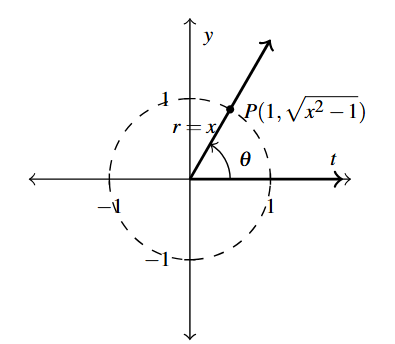
If, however, [latex]\frac{\pi}{2}[/latex] < [latex]t \leq \pi[/latex], then [latex]x = \sec(t) \leq -1[/latex], so we need to rewrite [latex]\sec(\theta) = x = \frac{x}{1} = \frac{-x}{-1}[/latex] in order to keep the radius of the circle, [latex]r = -x > 0[/latex] and the abscissa, [latex]-1[/latex] < 0. From [latex](-1)^2+y^2 = (-x)^2[/latex], we still get [latex]y = \sqrt{x^2-1}[/latex], as shown below.
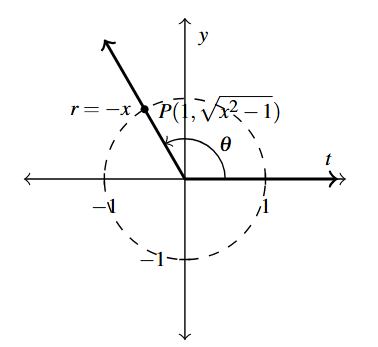
In the Quadrant I case, when [latex]x \geq 1[/latex], we get [latex]\tan(\theta) = \frac{\sqrt{x^2-1}}{1} = \sqrt{x^2-1}[/latex]. In Quadrant II, when [latex]x \leq -1[/latex], we obtain [latex]\tan(\theta) = \frac{\sqrt{x^2-1}}{-1} = - \sqrt{x^2-1}[/latex]. Hence, we get the piecewise definition for [latex]f(x)[/latex] as we did in number 2a above: [latex]f(x) = \tan(\text{arcsec}(x)) = \sqrt{x^2-1}[/latex] if [latex]x \geq 1[/latex] and [latex]f(x) = \tan(\text{arcsec}(x)) = -\sqrt{x^2-1}[/latex] if [latex]x \leq -1.[/latex]
The moral of the story here is that you are free to choose whichever route you like to simplify expressions like those found in Example 7.6.3 number 2a. Whether you choose identities or a more geometric route, just be careful to keep in mind which quadrants are in play, which variables represent which quantities, and what signs ([latex]\pm[/latex]) each should have.
7.6.4 Section Exercises
In Exercises 1 – 40, compute the exact value.
- [latex]\arcsin \left( -1 \right)[/latex]
- [latex]\arcsin \left( -\dfrac{\sqrt{3}}{2} \right)[/latex]
- [latex]\arcsin \left( -\dfrac{\sqrt{2}}{2} \right)[/latex]
- [latex]\arcsin \left( -\dfrac{1}{2} \right)[/latex]
- [latex]\arcsin \left( 0 \right)[/latex]
- [latex]\arcsin \left( \dfrac{1}{2} \right)[/latex]
- [latex]\arcsin \left( \dfrac{\sqrt{2}}{2} \right)[/latex]
- [latex]\arcsin \left( \dfrac{\sqrt{3}}{2} \right)[/latex]
- [latex]\arcsin \left( 1 \right)[/latex]
- [latex]\arccos \left( -1 \right)[/latex]
- [latex]\arccos \left( -\dfrac{\sqrt{3}}{2} \right)[/latex]
- [latex]\arccos \left( -\dfrac{\sqrt{2}}{2} \right)[/latex]
- [latex]\arccos \left( -\dfrac{1}{2} \right)[/latex]
- [latex]\arccos \left( 0 \right)[/latex]
- [latex]\arccos \left( \dfrac{1}{2} \right)[/latex]
- [latex]\arccos \left( \dfrac{\sqrt{2}}{2} \right)[/latex]
- [latex]\arccos \left( \dfrac{\sqrt{3}}{2} \right)[/latex]
- [latex]\arccos \left( 1 \right)[/latex]
- [latex]\arctan \left( -\sqrt{3} \right)[/latex]
- [latex]\arctan \left( -1 \right)[/latex]
- [latex]\arctan \left( -\dfrac{\sqrt{3}}{3} \right)[/latex]
- [latex]\arctan \left( 0 \right)[/latex]
- [latex]\arctan \left( \dfrac{\sqrt{3}}{3} \right)[/latex]
- [latex]\arctan \left( 1 \right)[/latex]
- [latex]\arctan \left( \sqrt{3} \right)[/latex]
- [latex]\text{arccot} \left( -\sqrt{3} \right)[/latex]
- [latex]\text{arccot} \left( -1 \right)[/latex]
- [latex]\text{arccot} \left( -\dfrac{\sqrt{3}}{3} \right)[/latex]
- [latex]\text{arccot} \left( 0 \right)[/latex]
- [latex]\text{arccot} \left( \dfrac{\sqrt{3}}{3} \right)[/latex]
- [latex]\text{arccot} \left( 1 \right)[/latex]
- [latex]\text{arccot} \left( \sqrt{3} \right)[/latex]
- [latex]\text{arcsec} \left( 2 \right)[/latex]
- [latex]\text{arccsc} \left( 2 \right)[/latex]
- [latex]\text{arcsec} \left( \sqrt{2} \right)[/latex]
- [latex]\text{arccsc} \left( \sqrt{2} \right)[/latex]
- [latex]\text{arcsec} \left( \dfrac{2\sqrt{3}}{3} \right)[/latex]
- [latex]\text{arccsc} \left( \dfrac{2\sqrt{3}}{3} \right)[/latex]
- [latex]\text{arcsec} \left( 1 \right)[/latex]
- [latex]\text{arccsc} \left( 1 \right)[/latex]
In Exercises 41 – 48, assume that the range of arcsecant is [latex]\left[0, \frac{\pi}{2} \right) \cup \left( \frac{\pi}{2}, \pi \right][/latex] and that the range of arccosecant is [latex]\left[ -\frac{\pi}{2}, 0 \right) \cup \left(0, \frac{\pi}{2} \right][/latex] when finding the exact value.
- [latex]\text{arcsec} \left( -2 \right)[/latex]
- [latex]\text{arcsec} \left( -\sqrt{2} \right)[/latex]
- [latex]\text{arcsec} \left( -\dfrac{2\sqrt{3}}{3} \right)[/latex]
- [latex]\text{arcsec} \left( -1 \right)[/latex]
- [latex]\text{arccsc} \left( -2 \right)[/latex]
- [latex]\text{arccsc} \left( -\sqrt{2} \right)[/latex]
- [latex]\text{arccsc} \left( -\dfrac{2\sqrt{3}}{3} \right)[/latex]
- [latex]\text{arccsc} \left( -1 \right)[/latex]
In Exercises 49 – 56, assume that the range of arcsecant is [latex]\left[0, \frac{\pi}{2} \right) \cup \left[\pi, \frac{3\pi}{2} \right)[/latex] and that the range of arccosecant is [latex]\left(0, \frac{\pi}{2} \right] \cup \left( \pi, \frac{3\pi}{2} \right][/latex] when finding the exact value.
- [latex]\text{arcsec} \left( -2 \right)[/latex]
- [latex]\text{arcsec} \left( -\sqrt{2} \right)[/latex]
- [latex]\text{arcsec} \left( -\dfrac{2\sqrt{3}}{3} \right)[/latex]
- [latex]\text{arcsec} \left( -1 \right)[/latex]
- [latex]\text{arccsc} \left( -2 \right)[/latex]
- [latex]\text{arccsc} \left( -\sqrt{2} \right)[/latex]
- [latex]\text{arccsc} \left( -\dfrac{2\sqrt{3}}{3} \right)[/latex]
- [latex]\text{arccsc} \left( -1 \right)[/latex]
In Exercises 57 – 86, determine the exact value or state that it is undefined.
- [latex]\sin\left(\arcsin\left(\dfrac{1}{2}\right)\right)[/latex]
- [latex]\sin\left(\arcsin\left(-\dfrac{\sqrt{2}}{2}\right)\right)[/latex]
- [latex]\sin\left(\arcsin\left(\dfrac{3}{5}\right)\right)[/latex]
- [latex]\sin\left(\arcsin\left(-0.42\right)\right)[/latex]
- [latex]\sin\left(\arcsin\left(\dfrac{5}{4}\right)\right)[/latex]
- [latex]\cos\left(\arccos\left(\dfrac{\sqrt{2}}{2}\right)\right)[/latex]
- [latex]\cos\left(\arccos\left(-\dfrac{1}{2}\right)\right)[/latex]
- [latex]\cos\left(\arccos\left(\dfrac{5}{13}\right)\right)[/latex]
- [latex]\cos\left(\arccos\left(-0.998\right)\right)[/latex]
- [latex]\cos\left(\arccos\left(\pi \right)\right)[/latex]
- [latex]\tan\left(\arctan\left(-1\right)\right)[/latex]
- [latex]\tan\left(\arctan\left(\sqrt{3}\right)\right)[/latex]
- [latex]\tan\left(\arctan\left(\dfrac{5}{12}\right)\right)[/latex]
- [latex]\tan\left(\arctan\left(0.965\right)\right)[/latex]
- [latex]\tan\left(\arctan\left( 3\pi \right)\right)[/latex]
- [latex]\cot\left(\text{arccot}\left(1\right)\right)[/latex]
- [latex]\cot\left(\text{arccot}\left(-\sqrt{3}\right)\right)[/latex]
- [latex]\cot\left(\text{arccot}\left(-\dfrac{7}{24}\right)\right)[/latex]
- [latex]\cot\left(\text{arccot}\left(-0.001\right)\right)[/latex]
- [latex]\cot\left(\text{arccot}\left( \dfrac{17\pi}{4} \right)\right)[/latex]
- [latex]\sec\left(\text{arcsec}\left(2\right)\right)[/latex]
- [latex]\sec\left(\text{arcsec}\left(-1\right)\right)[/latex]
- [latex]\sec\left(\text{arcsec}\left(\dfrac{1}{2}\right)\right)[/latex]
- [latex]\sec\left(\text{arcsec}\left(0.75\right)\right)[/latex]
- [latex]\sec\left(\text{arcsec}\left( 117\pi \right)\right)[/latex]
- [latex]\csc\left(\text{arccsc}\left(\sqrt{2}\right)\right)[/latex]
- [latex]\csc\left(\text{arccsc}\left(-\dfrac{2\sqrt{3}}{3}\right)\right)[/latex]
- [latex]\csc\left(\text{arccsc}\left(\dfrac{\sqrt{2}}{2}\right)\right)[/latex]
- [latex]\csc\left(\text{arccsc}\left(1.0001\right)\right)[/latex]
- [latex]\csc\left(\text{arccsc}\left( \dfrac{\pi}{4} \right)\right)[/latex]
In Exercises 87 – 106, determine the exact value or state that it is undefined.
- [latex]\arcsin\left(\sin\left(\dfrac{\pi}{6}\right) \right)[/latex]
- [latex]\arcsin\left(\sin\left(-\dfrac{\pi}{3}\right) \right)[/latex]
- [latex]\arcsin\left(\sin\left(\dfrac{3\pi}{4}\right) \right)[/latex]
- [latex]\arcsin\left(\sin\left(\dfrac{11\pi}{6}\right) \right)[/latex]
- [latex]\arcsin\left(\sin\left(\dfrac{4\pi}{3}\right) \right)[/latex]
- [latex]\arccos\left(\cos\left(\dfrac{\pi}{4}\right) \right)[/latex]
- [latex]\arccos\left(\cos\left(\dfrac{2\pi}{3}\right) \right)[/latex]
- [latex]\arccos\left(\cos\left(\dfrac{3\pi}{2}\right) \right)[/latex]
- [latex]\arccos\left(\cos\left(-\dfrac{\pi}{6}\right) \right)[/latex]
- [latex]\arccos\left(\cos\left(\dfrac{5\pi}{4}\right) \right)[/latex]
- [latex]\arctan\left(\tan\left(\dfrac{\pi}{3}\right) \right)[/latex]
- [latex]\arctan\left(\tan\left(-\dfrac{\pi}{4}\right) \right)[/latex]
- [latex]\arctan\left(\tan\left(\pi\right) \right)[/latex]
- [latex]\arctan\left(\tan\left(\dfrac{\pi}{2}\right) \right)[/latex]
- [latex]\arctan\left(\tan\left(\dfrac{2\pi}{3}\right) \right)[/latex]
- [latex]\text{arccot}\left(\cot\left(\dfrac{\pi}{3}\right) \right)[/latex]
- [latex]\text{arccot}\left(\cot\left(-\dfrac{\pi}{4}\right) \right)[/latex]
- [latex]\text{arccot}\left(\cot\left(\pi\right) \right)[/latex]
- [latex]\text{arccot}\left(\cot\left(\dfrac{\pi}{2}\right) \right)[/latex]
- [latex]\text{arccot}\left(\cot\left(\dfrac{2\pi}{3}\right) \right)[/latex]
In Exercises 107 – 118, assume that the range of arcsecant is [latex]\left[0, \frac{\pi}{2} \right) \cup \left( \frac{\pi}{2}, \pi \right][/latex] and that the range of arccosecant is [latex]\left[ -\frac{\pi}{2}, 0 \right) \cup \left(0, \frac{\pi}{2} \right][/latex] when finding the exact value.
- [latex]\text{arcsec}\left(\sec\left(\dfrac{\pi}{4}\right) \right)[/latex]
- [latex]\text{arcsec}\left(\sec\left(\dfrac{4\pi}{3}\right) \right)[/latex]
- [latex]\text{arcsec}\left(\sec\left( \dfrac{5\pi}{6} \right) \right)[/latex]
- [latex]\text{arcsec}\left(\sec\left(-\dfrac{\pi}{2} \right) \right)[/latex]
- [latex]\text{arcsec}\left(\sec\left(\dfrac{5\pi}{3}\right) \right)[/latex]
- [latex]\text{arccsc}\left(\csc\left(\dfrac{\pi}{6}\right) \right)[/latex]
- [latex]\text{arccsc}\left(\csc\left(\dfrac{5\pi}{4}\right) \right)[/latex]
- [latex]\text{arccsc}\left(\csc\left( \dfrac{2\pi}{3} \right) \right)[/latex]
- [latex]\text{arccsc}\left(\csc\left(-\dfrac{\pi}{2} \right) \right)[/latex]
- [latex]\text{arccsc}\left(\csc\left(\dfrac{11\pi}{6}\right) \right)[/latex]
- [latex]\text{arcsec}\left(\sec\left(\dfrac{11\pi}{12}\right) \right)[/latex]
- [latex]\text{arccsc}\left(\csc\left(\dfrac{9\pi}{8}\right) \right)[/latex]
In Exercises 119 – 130, assume that the range of arcsecant is [latex]\left[0, \frac{\pi}{2} \right) \cup \left[\pi, \frac{3\pi}{2} \right)[/latex] and that the range of arccosecant is [latex]\left(0, \frac{\pi}{2} \right] \cup \left( \pi, \frac{3\pi}{2} \right][/latex] when finding the exact value.
- [latex]\text{arcsec}\left(\sec\left(\dfrac{\pi}{4}\right) \right)[/latex]
- [latex]\text{arcsec}\left(\sec\left(\dfrac{4\pi}{3}\right) \right)[/latex]
- [latex]\text{arcsec}\left(\sec\left( \dfrac{5\pi}{6} \right) \right)[/latex]
- [latex]\text{arcsec}\left(\sec\left(-\dfrac{\pi}{2} \right) \right)[/latex]
- [latex]\text{arcsec}\left(\sec\left(\dfrac{5\pi}{3}\right) \right)[/latex]
- [latex]\text{arccsc}\left(\csc\left(\dfrac{\pi}{6}\right) \right)[/latex]
- [latex]\text{arccsc}\left(\csc\left(\dfrac{5\pi}{4}\right) \right)[/latex]
- [latex]\text{arccsc}\left(\csc\left( \dfrac{2\pi}{3} \right) \right)[/latex]
- [latex]\text{arccsc}\left(\csc\left(-\dfrac{\pi}{2} \right) \right)[/latex]
- [latex]\text{arccsc}\left(\csc\left(\dfrac{11\pi}{6}\right) \right)[/latex]
- [latex]\text{arcsec}\left(\sec\left(\dfrac{11\pi}{12}\right) \right)[/latex]
- [latex]\text{arccsc}\left(\csc\left(\dfrac{9\pi}{8}\right) \right)[/latex]
In Exercises 131 – 154, compute the exact value or state that it is undefined.
- [latex]\sin\left(\arccos\left(-\dfrac{1}{2}\right)\right)[/latex]
- [latex]\sin\left(\arccos\left(\dfrac{3}{5}\right)\right)[/latex]
- [latex]\sin\left(\arctan\left(-2\right)\right)[/latex]
- [latex]\sin\left(\text{arccot}\left(\sqrt{5}\right)\right)[/latex]
- [latex]\sin\left(\text{arccsc}\left(-3\right)\right)[/latex]
- [latex]\cos\left(\arcsin\left(-\dfrac{5}{13}\right)\right)[/latex]
- [latex]\cos\left(\arctan\left(\sqrt{7} \right)\right)[/latex]
- [latex]\cos\left(\text{arccot}\left( 3 \right)\right)[/latex]
- [latex]\cos\left(\text{arcsec}\left( 5 \right)\right)[/latex]
- [latex]\tan\left(\arcsin\left(-\dfrac{2\sqrt{5}}{5}\right)\right)[/latex]
- [latex]\tan\left(\arccos\left(-\dfrac{1}{2}\right)\right)[/latex]
- [latex]\tan\left(\text{arcsec}\left(\dfrac{5}{3}\right)\right)[/latex]
- [latex]\tan\left(\text{arccot}\left( 12 \right)\right)[/latex]
- [latex]\cot\left(\arcsin\left(\dfrac{12}{13}\right)\right)[/latex]
- [latex]\cot\left(\arccos\left(\dfrac{\sqrt{3}}{2}\right)\right)[/latex]
- [latex]\cot\left(\text{arccsc}\left(\sqrt{5}\right)\right)[/latex]
- [latex]\cot\left(\arctan \left( 0.25 \right)\right)[/latex]
- [latex]\sec\left(\arccos\left(\dfrac{\sqrt{3}}{2}\right)\right)[/latex]
- [latex]\sec\left(\arcsin\left(-\dfrac{12}{13}\right)\right)[/latex]
- [latex]\sec\left(\arctan\left(10\right)\right)[/latex]
- [latex]\sec\left(\text{arccot}\left(-\dfrac{\sqrt{10}}{10}\right)\right)[/latex]
- [latex]\csc\left(\text{arccot}\left(9 \right)\right)[/latex]
- [latex]\csc\left(\arcsin\left(\dfrac{3}{5}\right)\right)[/latex]
- [latex]\csc\left(\arctan\left(-\dfrac{2}{3}\right)\right)[/latex]
In Exercises 155 – 164, determine the exact value or state that it is undefined.
- [latex]\sin\left(\arcsin\left( \dfrac{5}{13} \right) + \dfrac{\pi}{4}\right)[/latex]
- [latex]\cos\left( \text{arcsec}(3) + \arctan(2) \right)[/latex]
- [latex]\tan\left( \arctan(3) + \arccos\left(-\dfrac{3}{5}\right) \right)[/latex]
- [latex]\sin\left(2\arcsin\left(-\dfrac{4}{5}\right)\right)[/latex]
- [latex]\sin\left(2\text{arccsc}\left(\dfrac{13}{5}\right)\right)[/latex]
- [latex]\sin\left(2\arctan\left(2\right)\right)[/latex]
- [latex]\cos\left(2 \arcsin\left(\dfrac{3}{5}\right)\right)[/latex]
- [latex]\cos\left(2 \text{arcsec}\left(\dfrac{25}{7}\right)\right)[/latex]
- [latex]\cos\left(2 \text{arccot}\left(-\sqrt{5}\right)\right)[/latex]
- [latex]\sin\left( \dfrac{\arctan(2)}{2} \right)[/latex]
In Exercises 165 – 184, rewrite each of the following composite functions as algebraic functions of [latex]x[/latex] and state the domain.
- [latex]f(x) = \sin \left( \arccos \left( x \right) \right)[/latex]
- [latex]f(x) = \cos \left( \arctan \left( x \right) \right)[/latex]
- [latex]f(x) = \tan \left( \arcsin \left( x \right) \right)[/latex]
- [latex]f(x) = \sec \left( \arctan \left( x \right) \right)[/latex]
- [latex]f(x) = \csc \left( \arccos \left( x \right) \right)[/latex]
- [latex]f(x) = \sin \left( 2\arctan \left( x \right) \right)[/latex]
- [latex]f(x) = \sin \left( 2\arccos \left( x \right) \right)[/latex]
- [latex]f(x) = \cos \left( 2\arctan \left( x \right) \right)[/latex]
- [latex]f(x) = \sin(\arccos(2x))[/latex]
- [latex]f(x) = \sin\left(\arccos\left(\dfrac{x}{5}\right)\right)[/latex]
- [latex]f(x) = \cos\left(\arcsin\left(\dfrac{x}{2}\right)\right)[/latex]
- [latex]f(x) = \cos\left(\arctan\left(3x\right)\right)[/latex]
- [latex]f(x) = \sin(2\arcsin(7x))[/latex]
- [latex]f(x) = \sin\left(2 \arcsin\left( \dfrac{x\sqrt{3}}{3} \right) \right)[/latex]
- [latex]f(x) = \cos(2 \arcsin(4x))[/latex]
- [latex]f(x) = \sec(\arctan(2x))\tan(\arctan(2x))[/latex]
- [latex]f(x) = \sin \left( \arcsin(x) + \arccos(x) \right)[/latex]
- [latex]f(x) = \cos \left( \arcsin(x) + \arctan(x) \right)[/latex]
- [latex]f(x) = \tan \left( 2\arcsin(x) \right)[/latex]
- [latex]f(x) = \sin \left( \dfrac{1}{2}\arctan(x) \right)[/latex]
- If [latex]\theta = \arcsin\left(\dfrac{x}{2}\right)[/latex], find an expression for [latex]\theta + \sin(2\theta)[/latex] in terms of [latex]x[/latex].
- If [latex]\theta = \arctan\left(\dfrac{x}{7}\right)[/latex], find an expression for [latex]\dfrac{1}{2}\theta - \dfrac{1}{2}\sin(2\theta)[/latex] in terms of [latex]x[/latex].
- If [latex]\theta = \text{arcsec}\left(\dfrac{x}{4}\right)[/latex], find an expression for [latex]4\tan(\theta) - 4\theta[/latex] in terms of [latex]x[/latex] assuming [latex]x \geq 4.[/latex]
In Exercises 188 – 199, find the domain of the given function. Write your answers in interval notation.
- [latex]f(x) = \arcsin(5x)[/latex]
- [latex]f(x) = \arccos\left(\dfrac{3x-1}{2} \right)[/latex]
- [latex]f(x) = \arcsin\left(2x^2\right)[/latex]
- [latex]f(x) = \arccos\left(\dfrac{1}{x^2-4}\right)[/latex]
- [latex]f(x) = \arctan(4x)[/latex]
- [latex]f(x) = \text{arccot}\left(\dfrac{2x}{x^2-9}\right)[/latex]
- [latex]f(x) =\arctan(\ln(2x-1))[/latex]
- [latex]f(x) = \text{arccot}(\sqrt{2x-1})[/latex]
- [latex]f(x) = \text{arcsec}(12x)[/latex]
- [latex]f(x) = \text{arccsc}(x+5)[/latex]
- [latex]f(x) = \text{arcsec}\left(\dfrac{x^3}{8}\right)[/latex]
- [latex]f(x) = \text{arccsc}\left(e^{2x}\right)[/latex]
- Use the diagram below along with the accompanying questions to show: \[\arctan(1) + \arctan(2) + \arctan(3) = \pi\]
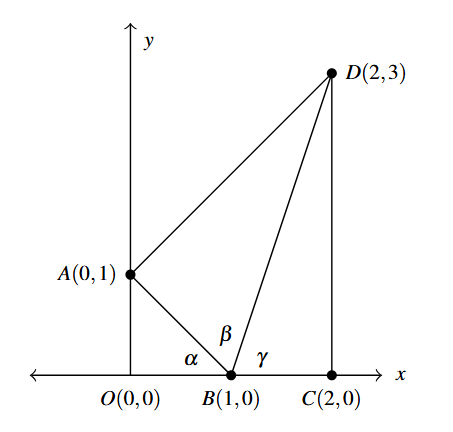
Diagram for Exercise 200 - Clearly [latex]\triangle AOB[/latex] and [latex]\triangle BCD[/latex] are right triangles because the line through [latex]O[/latex] and [latex]A[/latex] and the line through [latex]C[/latex] and [latex]D[/latex] are perpendicular to the [latex]x[/latex]-axis. Use the distance formula to show that [latex]\triangle BAD[/latex] is also a right triangle (with [latex]\angle BAD[/latex] being the right angle) by showing that the sides of the triangle satisfy the Pythagorean Theorem.
- Use [latex]\triangle AOB[/latex] to show that [latex]\alpha = \arctan(1)[/latex]
- Use [latex]\triangle BAD[/latex] to show that [latex]\beta = \arctan(2)[/latex]
- Use [latex]\triangle BCD[/latex] to show that [latex]\gamma = \arctan(3)[/latex]
- Use the fact that [latex]O[/latex], [latex]B[/latex] and [latex]C[/latex] all lie on the [latex]x[/latex]-axis to conclude that [latex]\alpha + \beta + \gamma = \pi[/latex]. Thus [latex]\arctan(1) + \arctan(2) + \arctan(3) = \pi[/latex].
Section 7.6 Exercise Answers can be found in the Appendix.
- We have already discussed this concept in Section 7.2.1 as the angle finder in the context of acute angles in right triangles. ↵
- But be aware that many books do! As always, be sure to check the context! ↵
- We switch the input variable to the arcsine and arccosine functions to [latex]x[/latex] to avoid confusion with the outputs we label [latex]t[/latex]. ↵
- See Section 7.1 if you need a review of how we associate real numbers with angles in radian measure. ↵
- The Pythagorean Identities are a direct result of the definition of the six trigonometric functions on a right triangle. We will prove these identities in this example in Section 8.1. See Theorem 8.3 ↵
- Alternatively, we could use the identity: [latex]1 + \tan^{2}(t) = \sec^{2}(t)[/latex]. As [latex]x = \cos(t)[/latex], [latex]\sec(t) = \frac{1}{\cos(t)} = \frac{1}{x}[/latex]. The reader is invited to work through this approach to see what, if any, difficulties arise. ↵
- Alternatively, we can write the domain of [latex]\text{arccsc}(x)[/latex] as [latex]|x| \geq 1[/latex], so the domain of [latex]\text{arccsc}(4x)[/latex] is [latex]|4x| \geq 1[/latex]. ↵
- We'll avoid the label [latex]x[/latex]-coordinate here because as we'll see, the quantity [latex]x[/latex] in this problem is tied to the radius as opposed to the coordinates of points on the terminal side of [latex]\theta[/latex]. ↵

